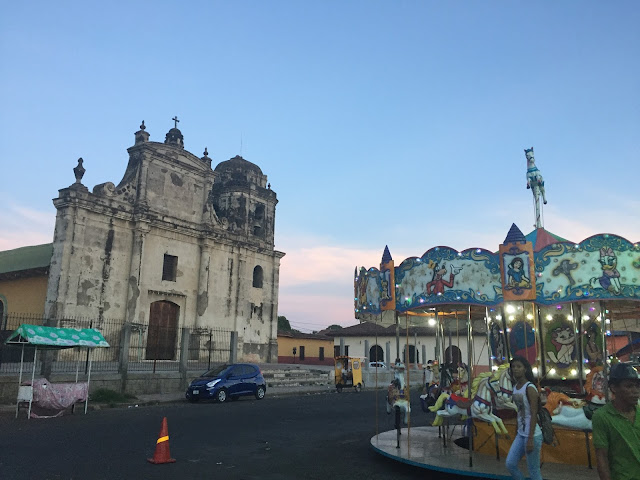We also went to the house/museum of Rubén Darío and the Ortiz-Guardián contemporary museum of Latin American Art. The art museum was very peaceful, especially sitting in the picturesque courtyards looking at enormous paintings hanging on the walls.
 |
| One courtyard of many in the art museum |
In León, and a lot of other cities including in China, there are no front yards. Instead all of the houses have lush courtyards, and all the rooms shoot off of the surrounding covered promenade. Both sides of the street outside are just walls of the houses. Many houses here have a wrought iron gate that opens to let their car park on the inside of the house.
Friday, we went to the nearby town of Nagarote to meet with Sostenica, a nonprofit that promotes sustainable agriculture and lifestyles among farmers of that region (sostenica.org). The CEO is a Yale (Branford) grad who reached out to us and set us up with a tour of their Ecocenter. There are an enormous number of nonprofits around León, and a surprising number have Yale connections, partly due to the Sister City Project which connects León and New Haven. The most interesting project Sostenica is working on is to replace wood-burning stoves common in the small houses and huts of farmers. The stoves cause a huge amount of indoor air pollution which causes severe health impairments for members of the family, disproportionately womyn and children who are always cooking or sleeping near the stove. The stoves are also hot to the touch and can cause burns or even fires. Sostenica and some other groups are trying to install new cement stoves with a better design that sends the smoke out via a small chimney.
The best part of the tranquil town of Nagarote was the quesillos. Nagarote has a contested claim as the home of "a thick, steaming corn tortilla topped with a pancake of mozzarella-like cheese, then loosely rolled into a cylinder and fitted into a special plastic bag" (Lonely Planet), a famous national dish. (Nicaragua's street food vendors are all about plastic bags.) To go with the quesillo, I got to drink tiste, a traditional drink of maize, cacao, and maybe some other ground-up ingredients--similarly served in a bag with a straw. It tasted quite like iced chai tea!
Sunday, we went to the ruins of León Viejo, an abandoned city (thanks volcanic ash!) from the 1500s nestled among volcanoes and lakes. The bus rides there were an adventure in themselves, and a great exploration into the essence of Nicaragua--dirt roads dwarfed by volcanoes, mountains, lakes, jungles, and grasslands. León Viejo was the second UNESCO World Heritage site I've seen since being here (the other being the basilica) so they must not be that common since ole lil León has two. I tried to talk the ticket seller into giving me the Nicaraguan student price but to no avail as we ended up paying the foreigner price which is about three times as expensive as the nationals price. Not sure if this is because it's like "the Nicaraguans birth right" or because they know the foreigners are loaded in relation. There's not any open hostility to white Americans however, which I almost would've expected due to how awful the United States' foreign policy was towards Nicaragua for so long (i.e. supporting a heinous line of dictators). There are a few public buses which say Down with the Yankee on them, and also a tattoo parlor near us called the White Devil, but overall not bad...
 |
| View of mountains from the ruins of the fortress of Leon Viejo |
I've been loving the gym which is just a big open garage that's always blasting Latin music. No other Americans spotted there yet (the tourists tend to stay in the area I've termed Gringo Street with all the hostels and bars. There's way more foreign tourists than I was anticipating, and a lot from the Bible Belt here for mission work.) At one point I watching the U.S. Argentina soccer game on a treadmill in between two Nicaraguan dudes who were cheering every time I was booing. The trainer Martín is super friendly and keeps people from stealing my bench press. Plenty of womyn there which was a bit unexpected--I am the only one who ever wears shorts at the gym though, even though it's cray hot and stuffy. I haven't seen any womyn under 50 with short hair either. I wonder which aspect of the culture has influenced this the most, whether it's the intense sexualization of womyn here or more the intense heat and humidity (which drives them to keep their hair usually up in ponytails, buns, and braids). It's driving me to want to cut mine way shorter (hi Stella!).
All of these adventures were due to the fact that we were waiting for the changes to our pilot study to be approved by the Yale IRB board so that we can start actually collecting data this week! It's been pretty rough for my teammates; Sarah and Hannah have been sick and out of commission for about 75% of their time here so far.


























